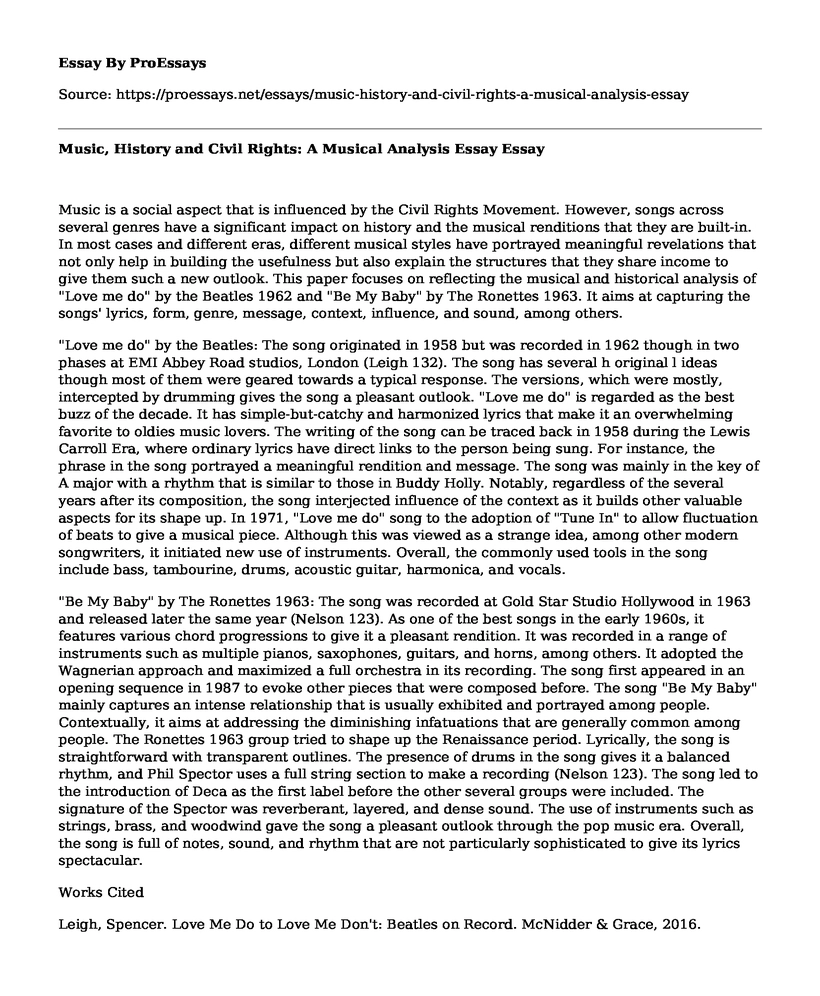Music is a social aspect that is influenced by the Civil Rights Movement. However, songs across several genres have a significant impact on history and the musical renditions that they are built-in. In most cases and different eras, different musical styles have portrayed meaningful revelations that not only help in building the usefulness but also explain the structures that they share income to give them such a new outlook. This paper focuses on reflecting the musical and historical analysis of "Love me do" by the Beatles 1962 and "Be My Baby" by The Ronettes 1963. It aims at capturing the songs' lyrics, form, genre, message, context, influence, and sound, among others.
"Love me do" by the Beatles: The song originated in 1958 but was recorded in 1962 though in two phases at EMI Abbey Road studios, London (Leigh 132). The song has several h original l ideas though most of them were geared towards a typical response. The versions, which were mostly, intercepted by drumming gives the song a pleasant outlook. "Love me do" is regarded as the best buzz of the decade. It has simple-but-catchy and harmonized lyrics that make it an overwhelming favorite to oldies music lovers. The writing of the song can be traced back in 1958 during the Lewis Carroll Era, where ordinary lyrics have direct links to the person being sung. For instance, the phrase in the song portrayed a meaningful rendition and message. The song was mainly in the key of A major with a rhythm that is similar to those in Buddy Holly. Notably, regardless of the several years after its composition, the song interjected influence of the context as it builds other valuable aspects for its shape up. In 1971, "Love me do" song to the adoption of "Tune In" to allow fluctuation of beats to give a musical piece. Although this was viewed as a strange idea, among other modern songwriters, it initiated new use of instruments. Overall, the commonly used tools in the song include bass, tambourine, drums, acoustic guitar, harmonica, and vocals.
"Be My Baby" by The Ronettes 1963: The song was recorded at Gold Star Studio Hollywood in 1963 and released later the same year (Nelson 123). As one of the best songs in the early 1960s, it features various chord progressions to give it a pleasant rendition. It was recorded in a range of instruments such as multiple pianos, saxophones, guitars, and horns, among others. It adopted the Wagnerian approach and maximized a full orchestra in its recording. The song first appeared in an opening sequence in 1987 to evoke other pieces that were composed before. The song "Be My Baby" mainly captures an intense relationship that is usually exhibited and portrayed among people. Contextually, it aims at addressing the diminishing infatuations that are generally common among people. The Ronettes 1963 group tried to shape up the Renaissance period. Lyrically, the song is straightforward with transparent outlines. The presence of drums in the song gives it a balanced rhythm, and Phil Spector uses a full string section to make a recording (Nelson 123). The song led to the introduction of Deca as the first label before the other several groups were included. The signature of the Spector was reverberant, layered, and dense sound. The use of instruments such as strings, brass, and woodwind gave the song a pleasant outlook through the pop music era. Overall, the song is full of notes, sound, and rhythm that are not particularly sophisticated to give its lyrics spectacular.
Works Cited
Leigh, Spencer. Love Me Do to Love Me Don't: Beatles on Record. McNidder & Grace, 2016.
Nelson, Emily. "Be My Baby:" Feminine Desire and Social Constructs in 1960s Culture." NORTHWEST PASSAGES (2018): 123.
Cite this page
Music, History and Civil Rights: A Musical Analysis Essay. (2023, Mar 29). Retrieved from https://proessays.net/essays/music-history-and-civil-rights-a-musical-analysis-essay
If you are the original author of this essay and no longer wish to have it published on the ProEssays website, please click below to request its removal:
- Sociology Essay Example: Agents of Socialization
- Essay Sample on Coca-Colas Social Media Use
- Movie Analysis Essay on Black Panther and Miss Bala
- Essay Example on Trifles: A Murder Mystery With Gender-Based Conflict
- Essay Sample on Good Grammar & Brevity: Keys to Technical Writing Success
- Facebook-Cambridge Analytica: The Data Scandal That Shook the World - Essay Sample
- Exploring Different Styles of Academic Writing - Essay Sample







